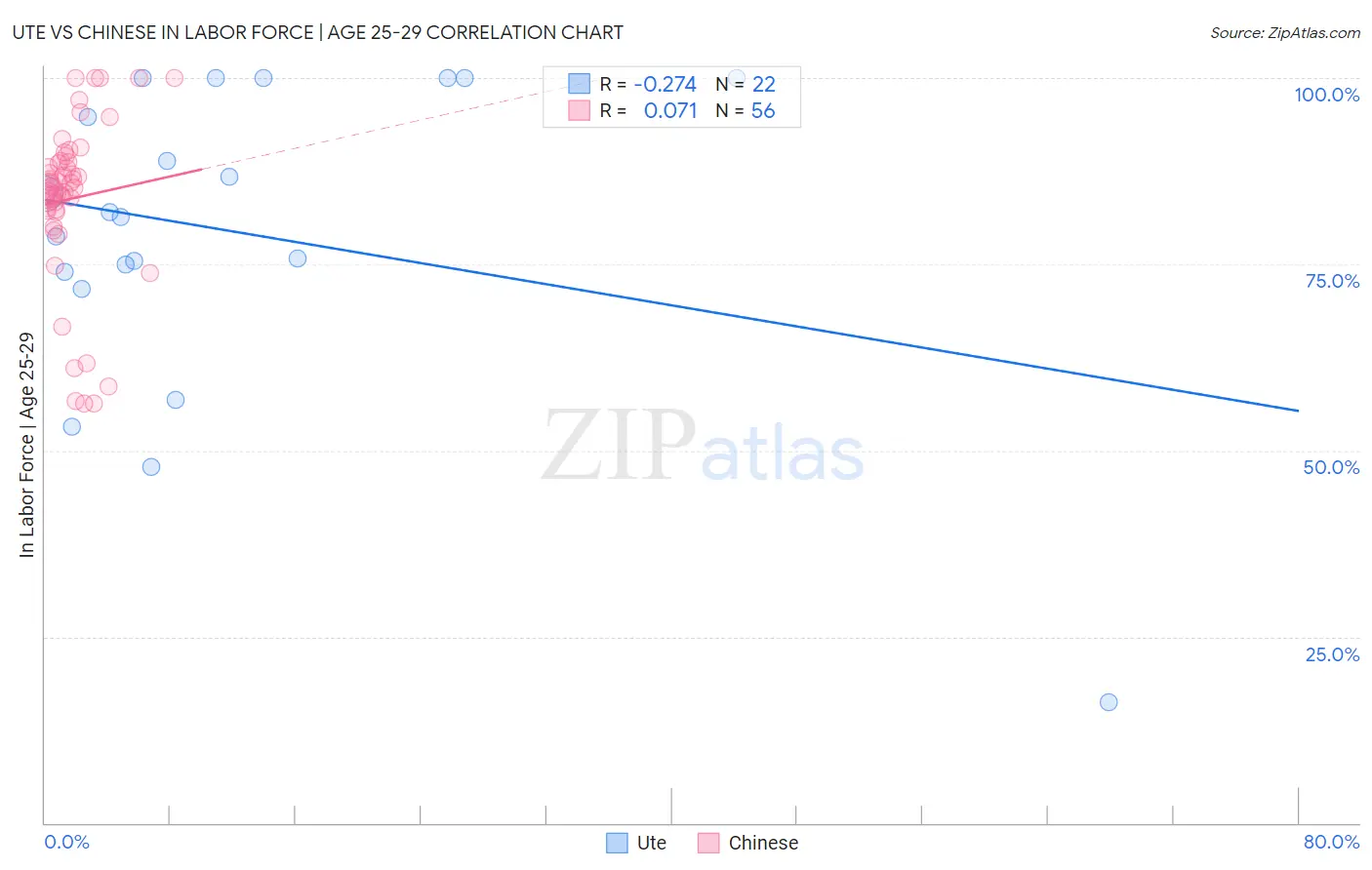Ute vs Chinese In Labor Force | Age 25-29
COMPARE
Ute
Chinese
In Labor Force | Age 25-29
In Labor Force | Age 25-29 Comparison
Ute
Chinese
80.8%
IN LABOR FORCE | AGE 25-29
0.0/ 100
METRIC RATING
327th/ 347
METRIC RANK
84.3%
IN LABOR FORCE | AGE 25-29
12.7/ 100
METRIC RATING
210th/ 347
METRIC RANK
Ute vs Chinese In Labor Force | Age 25-29 Correlation Chart
The statistical analysis conducted on geographies consisting of 55,662,248 people shows a weak negative correlation between the proportion of Ute and labor force participation rate among population between the ages 25 and 29 in the United States with a correlation coefficient (R) of -0.274 and weighted average of 80.8%. Similarly, the statistical analysis conducted on geographies consisting of 64,804,747 people shows a slight positive correlation between the proportion of Chinese and labor force participation rate among population between the ages 25 and 29 in the United States with a correlation coefficient (R) of 0.071 and weighted average of 84.3%, a difference of 4.4%.

In Labor Force | Age 25-29 Correlation Summary
| Measurement | Ute | Chinese |
| Minimum | 16.2% | 56.3% |
| Maximum | 100.0% | 100.0% |
| Range | 83.8% | 43.7% |
| Mean | 79.2% | 83.8% |
| Median | 81.7% | 85.3% |
| Interquartile 25% (IQ1) | 73.9% | 82.3% |
| Interquartile 75% (IQ3) | 100.0% | 88.8% |
| Interquartile Range (IQR) | 26.1% | 6.5% |
| Standard Deviation (Sample) | 21.0% | 10.9% |
| Standard Deviation (Population) | 20.5% | 10.8% |
Similar Demographics by In Labor Force | Age 25-29
Demographics Similar to Ute by In Labor Force | Age 25-29
In terms of in labor force | age 25-29, the demographic groups most similar to Ute are Creek (80.7%, a difference of 0.15%), Choctaw (81.0%, a difference of 0.20%), Yakama (80.6%, a difference of 0.26%), Dutch West Indian (81.1%, a difference of 0.41%), and Puerto Rican (80.4%, a difference of 0.48%).
| Demographics | Rating | Rank | In Labor Force | Age 25-29 |
| Colville | 0.0 /100 | #320 | Tragic 81.6% |
| Shoshone | 0.0 /100 | #321 | Tragic 81.6% |
| Kiowa | 0.0 /100 | #322 | Tragic 81.6% |
| Alaska Natives | 0.0 /100 | #323 | Tragic 81.6% |
| Houma | 0.0 /100 | #324 | Tragic 81.2% |
| Dutch West Indians | 0.0 /100 | #325 | Tragic 81.1% |
| Choctaw | 0.0 /100 | #326 | Tragic 81.0% |
| Ute | 0.0 /100 | #327 | Tragic 80.8% |
| Creek | 0.0 /100 | #328 | Tragic 80.7% |
| Yakama | 0.0 /100 | #329 | Tragic 80.6% |
| Puerto Ricans | 0.0 /100 | #330 | Tragic 80.4% |
| Cheyenne | 0.0 /100 | #331 | Tragic 80.3% |
| Inupiat | 0.0 /100 | #332 | Tragic 79.8% |
| Sioux | 0.0 /100 | #333 | Tragic 79.7% |
| Yuman | 0.0 /100 | #334 | Tragic 79.3% |
Demographics Similar to Chinese by In Labor Force | Age 25-29
In terms of in labor force | age 25-29, the demographic groups most similar to Chinese are Immigrants from Jordan (84.4%, a difference of 0.0%), Immigrants from Venezuela (84.3%, a difference of 0.0%), Immigrants from Armenia (84.4%, a difference of 0.010%), Immigrants from Indonesia (84.4%, a difference of 0.010%), and Subsaharan African (84.3%, a difference of 0.020%).
| Demographics | Rating | Rank | In Labor Force | Age 25-29 |
| Immigrants | Afghanistan | 15.6 /100 | #203 | Poor 84.4% |
| Venezuelans | 15.1 /100 | #204 | Poor 84.4% |
| Ecuadorians | 14.8 /100 | #205 | Poor 84.4% |
| Immigrants | Cambodia | 14.3 /100 | #206 | Poor 84.4% |
| Immigrants | Armenia | 13.3 /100 | #207 | Poor 84.4% |
| Immigrants | Indonesia | 13.2 /100 | #208 | Poor 84.4% |
| Immigrants | Jordan | 12.8 /100 | #209 | Poor 84.4% |
| Chinese | 12.7 /100 | #210 | Poor 84.3% |
| Immigrants | Venezuela | 12.6 /100 | #211 | Poor 84.3% |
| Sub-Saharan Africans | 11.7 /100 | #212 | Poor 84.3% |
| Japanese | 11.4 /100 | #213 | Poor 84.3% |
| Lebanese | 11.1 /100 | #214 | Poor 84.3% |
| Immigrants | Syria | 10.7 /100 | #215 | Poor 84.3% |
| Israelis | 9.3 /100 | #216 | Tragic 84.3% |
| Immigrants | Ecuador | 9.3 /100 | #217 | Tragic 84.3% |